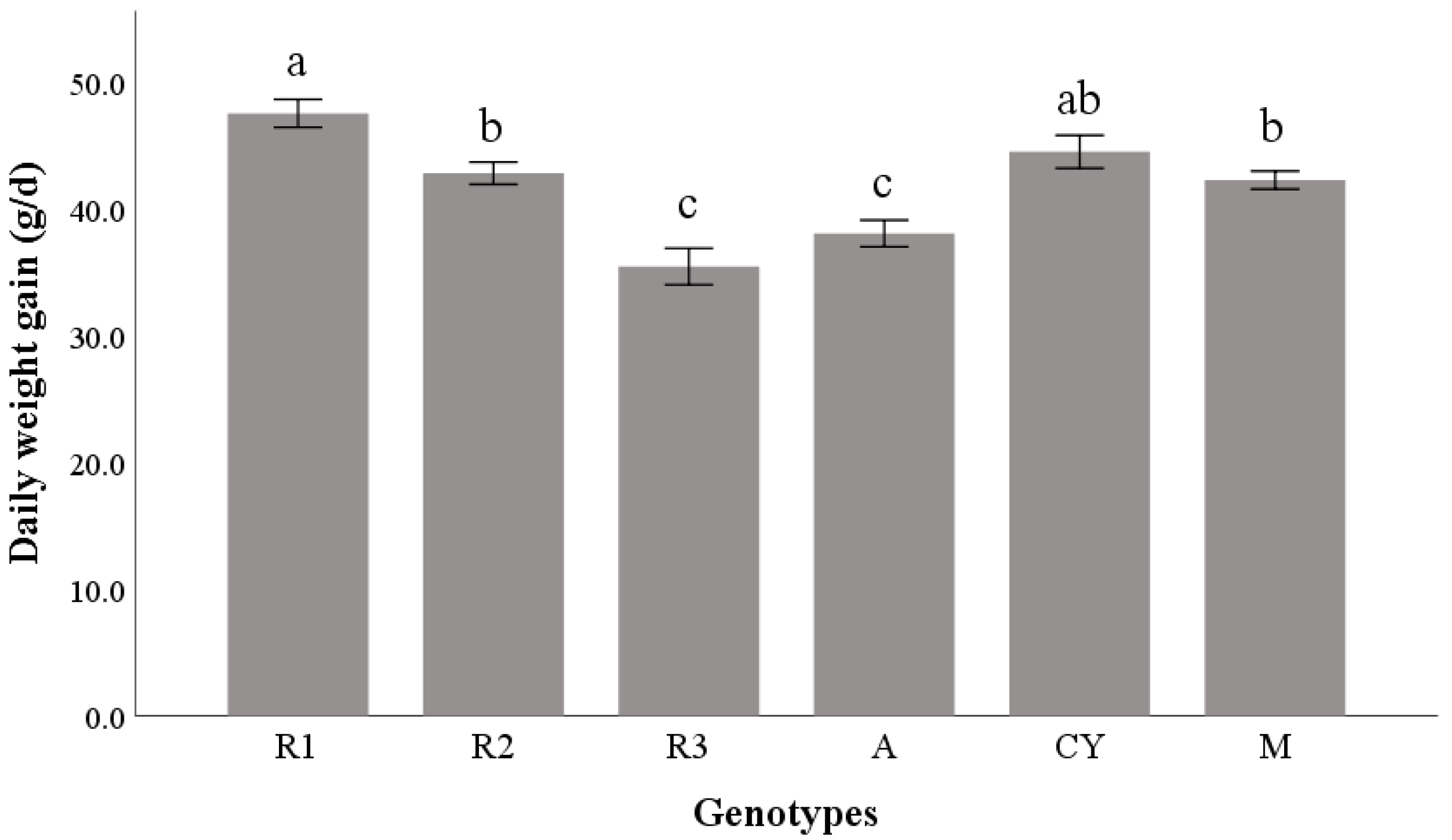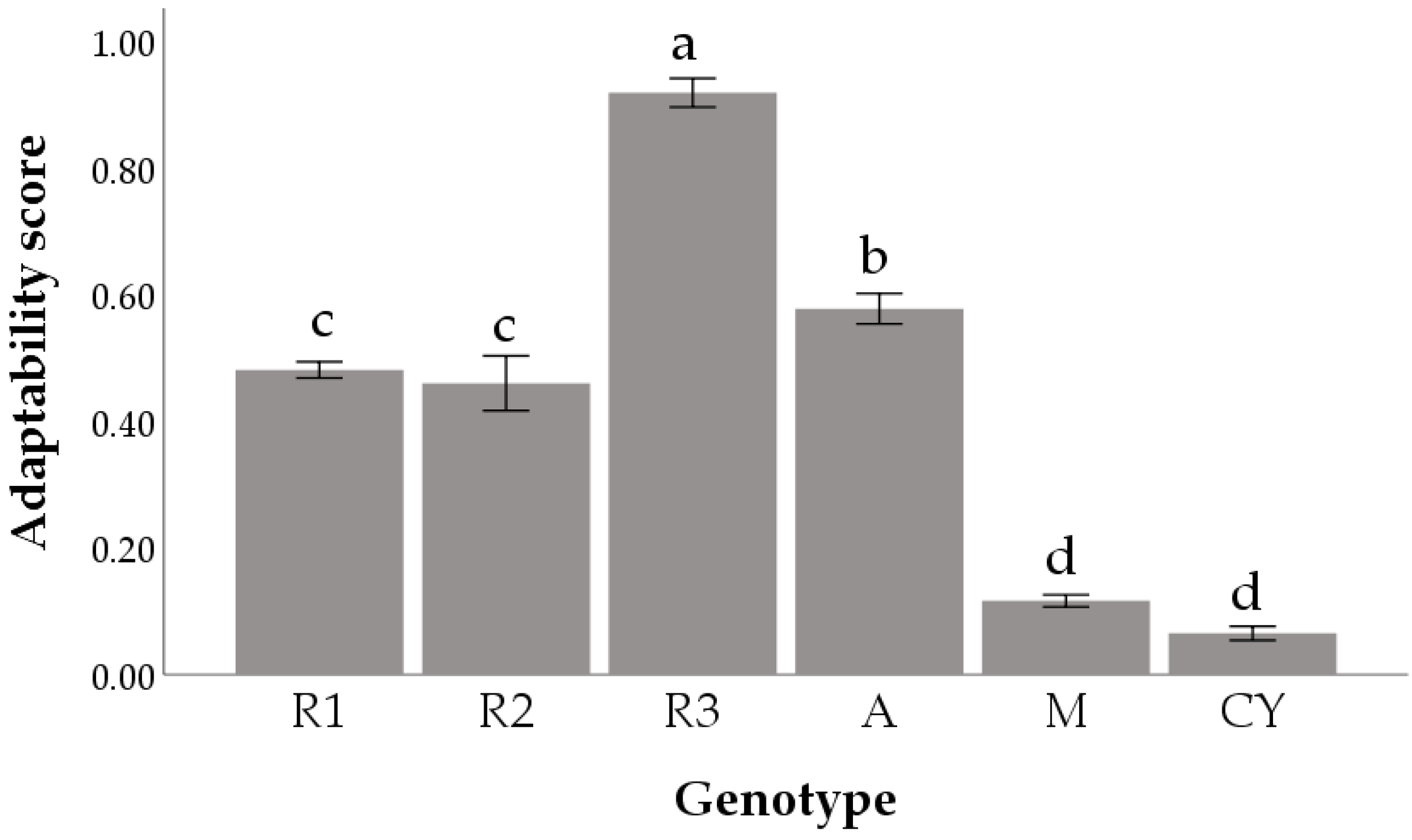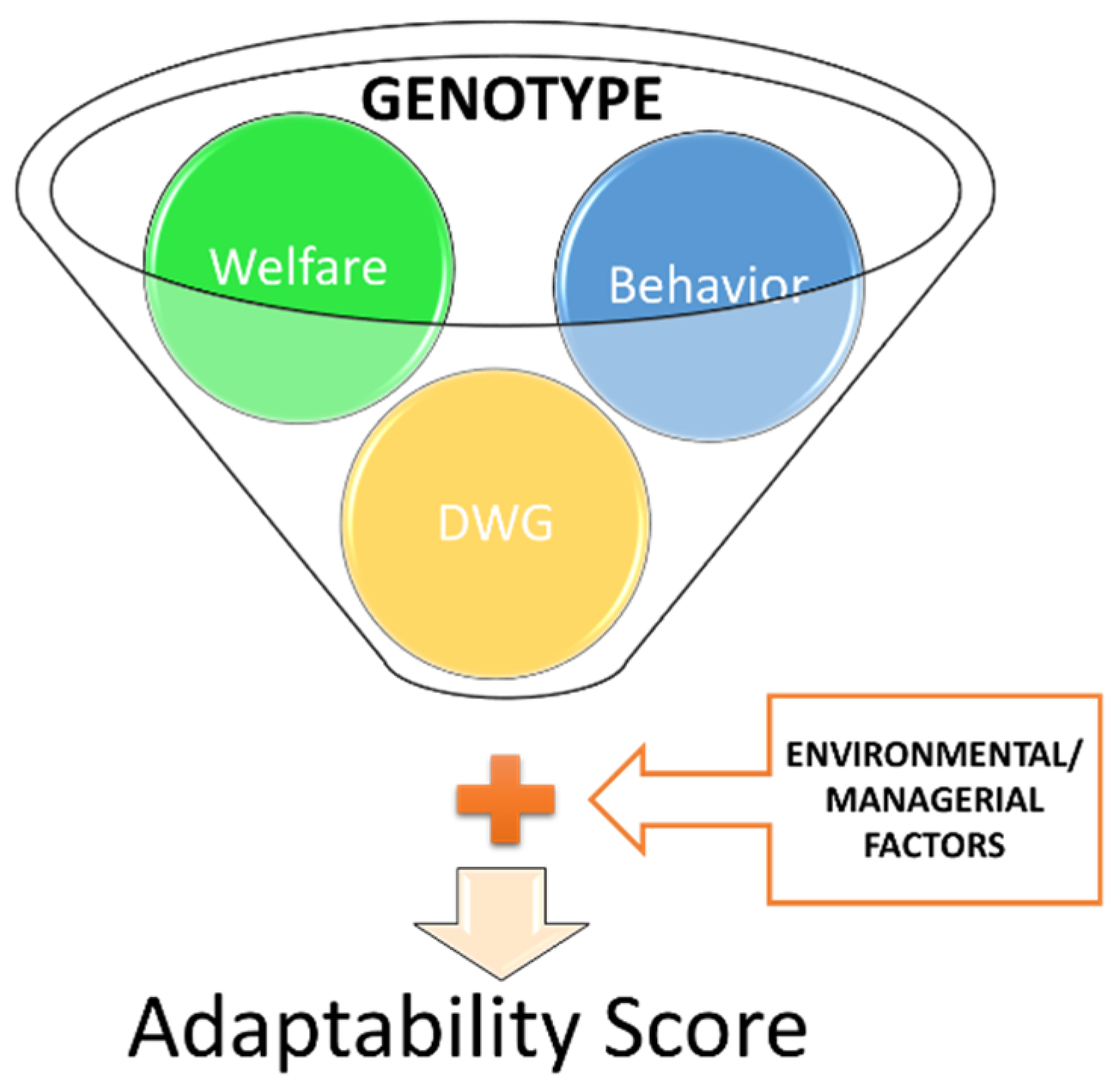The Assessment of a Multifactorial Score for the Adaptability Evaluation of Six Poultry Genotypes to the Organic System
Abstract
Simple Summary
Abstract
1. Introduction
2. Materials and Methods
2.1. Experimental Design
- Starting period, 0–21 d, 24.01% CP, and 3245.20 Kcal/kg ME;
- Growing period, 22–60 d, 22.16% CP, and 3242.64 Kcal/kg ME;
- Finishing period, 61–81 d, 18.41% CP, and 3295.94 Kcal/kg ME.
2.2. Behavioral Observations
2.3. Plumage Conditions and Body Lesions
2.4. Statistical Analysis
3. Results
3.1. Influence of Genotypes on Daily Weight Gain, Behavioral Parameters, and Plumage and Lesion Scores
3.2. Principal Component Analysis
3.3. Effect of Genotype and Daily Weight Gain on the Adaptability Score
4. Discussion
5. Conclusions
Supplementary Materials
Author Contributions
Funding
Institutional Review Board Statement
Data Availability Statement
Acknowledgments
Conflicts of Interest
References
- Aviagen. Available online: http://en.aviagen.com (accessed on 10 September 2021).
- Fanatico, A.C.; Pillai, P.B.; Hester, P.Y.; Falcone, C.; Mench, J.A.; Owens, C.M.; Emmert, J.L. Performance, livability, and carcass yield of slow-and fast-growing chicken genotypes fed low-nutrient or standard diets and raised indoors or with outdoor access. Poult. Sci. 2008, 87, 1012–1021. [Google Scholar] [CrossRef] [PubMed]
- Mikulski, D.; Celej, J.; Jankowski, J.; Majewska, T.; Mikulska, M. Growth performance, carcass traits and meat quality of slower-growing and fast-growing chickens raised with and without outdoor access. J. Anim. Sci. 2011, 24, 1407–1416. [Google Scholar] [CrossRef]
- Shim, M.Y.; Karnuah, A.B.; Mitchell, A.D.; Anthony, N.B.; Pesti, G.M.; Aggrey, S.E. The effects of growth rate on leg morphology and tibia breaking strength, mineral density, mineral content, and bone ash in broilers. Poult. Sci. 2012, 91, 1790–1795. [Google Scholar] [CrossRef] [PubMed]
- Adebambo, A.O.; Ikeobi, C.O.N.; Ozoje, M.O.; Oduguwa, O.O.; Olufunmilayo, A.A. Combining abilities of growth traits among pure and crossbred meat type chickens. Arch. Zootec. 2011, 60, 953–963. [Google Scholar] [CrossRef]
- Mancinelli, A.C.; Mattioli, S.; Bosco, A.D.; Castellini, C.; Mugnai, C.; Moscati, L.; Amato, M.G. Performance, behavior, and welfare status of six different organically reared poultry genotypes. Animals 2020, 10, 550. [Google Scholar] [CrossRef]
- Castellini, C.; Mugnai, C.; Moscati, L.; Mattioli, S.; Amato, M.G.; Mancinelli, A.C.; Dal Bosco, A. Adaptation to organic rearing system of eight different chicken genotypes: Behaviour, welfare and performance. J. Anim. Sci. 2016, 15, 37–46. [Google Scholar] [CrossRef]
- Dal Bosco, A.; Mattioli, S.; Mancinelli, A.C.; Cotozzolo, E.; Castellini, C. Extensive rearing systems in poultry production: The right chicken for the right farming system. A review of twenty years of scientific research in Perugia University, Italy. Animals 2021, 11, 1281. [Google Scholar] [CrossRef] [PubMed]
- National Research Council. Nutrient Requirements of Poultry, 9th ed.; National Academies Press: Washington, DC, USA, 1994. [Google Scholar] [CrossRef]
- NLewis, P.D.; Perry, G.C.; Farmer, L.J.; Patterson, R.L.S. Responses of two genotypes of chicken to the diets and stocking densities typical of UK and ‘Label Rouge’production systems: I. Performance, behaviour and carcass composition. Meat Sci. 1997, 45, 501–516. [Google Scholar] [CrossRef]
- Altmann, J. Observational study of behavior: Sampling methods. Behaviour 1974, 49, 227–266. [Google Scholar] [CrossRef] [PubMed]
- Tauson, R. Plumage condition in SCWL laying hens kept in conventional cages of different designs. Acta Agric. Scand. 1984, 34, 221–230. [Google Scholar] [CrossRef]
- Berg, C. Foot-pad dermatitis in broilers and turkeys. Acta Univ. Agric. Sueciae Vet. 1998, 36, 7–43. [Google Scholar]
- Field, A. Discovering Statistics Using SPSS; SAGE Publication: London, UK, 2009; ISBN 9781847879066. [Google Scholar]
- Righi, C.; Menchetti, L.; Orlandi, R.; Moscati, L.; Mancini, S.; Diverio, S. Welfare assessment in shelter dogs by using physiological and immunological parameters. Animals 2019, 9, 340. [Google Scholar] [CrossRef] [PubMed]
- Pituch, K.A.; Stevens, J.P. Applied Multivariate Statistics for the Social Sciences: Analyses with SAS and IBM’s SPSS, 6th ed.; Routledge: New York, NY, USA, 2015; p. 814. ISBN 9781315814919. [Google Scholar]
- Menchetti, L.; Righi, C.; Guelfi, G.; Enas, C.; Moscati, L.; Mancini, S.; Diverio, S. Multi-operator qualitative behavioural assessment for dogs entering the shelter. Appl. Anim. Behav. Sci. 2019, 213, 107–116. [Google Scholar] [CrossRef]
- Menchetti, L.; Calipari, S.; Guelfi, G.; Catanzaro, A.; Diverio, S. My dog is not my cat: Owner perception of the personalities of dogs and cats living in the same household. Animals 2018, 8, 80. [Google Scholar] [CrossRef] [PubMed]
- Meluzzi, A.; Sirri, F.; Mugnai, C.; Dal Bosco, A. Effect of genotype on welfare conditions of broilers reared under organic conditions. In Proceedings of the 8th European Symposium on Poultry Welfare, Cervia, Italy, 18–22 May 2009. [Google Scholar]
- Branciari, R.; Mugnai, C.; Mammoli, R.; Miraglia, D.; Ranucci, D.; Dal Bosco, A.; Castellini, C. Effect of genotype and rearing system on chicken behavior and muscle fiber characteristics. J. Anim. Sci. 2009, 87, 4109–4117. [Google Scholar] [CrossRef] [PubMed]
- Mattioli, S.; Mancinelli, A.C.; Menchetti, L.; Bosco, A.D.; Madeo, L.; Amato, M.G.; Moscati, L.; Cotozzolo, E.; Ciarelli, C.; Angelucci, E.; et al. How the kinetic behavior of organic chickens affects productive performance and blood and meat oxidative status: A study of six poultry genotypes. Poult Sci. 2021, 100, 101297. [Google Scholar] [CrossRef] [PubMed]
- Mattioli, S.; Dal Bosco, A.; Ruggeri, S.; Martino, M.; Moscati, L.; Pesca, C.; Castellini, C. Adaptive response to exercise of fast-growing and slow-growing chicken strains: Blood oxidative status and non-enzymatic antioxidant defense. Poult Sci. 2017, 96, 4096–4102. [Google Scholar] [CrossRef] [PubMed]
- Weeks, C.A.; Danbury, T.D.; Davies, H.C.; Hunt, P.; Kestin, S.C. The behaviour of broiler chickens and its modification by lameness. Appl. Anim. Behav. Sci. 2000, 67, 111–125. [Google Scholar] [CrossRef]
- Capucchio, M.T.; Colombino, E.; Tarantola, M.; Biagini, D.; Alborali, L.G.; Maisano, A.M.; Schiavone, A. The disturbed habitat and its effects on the animal population. Anim. Behav. 2019. [Google Scholar] [CrossRef][Green Version]



| Behavior Category | Behaviors | Description |
|---|---|---|
| Activity | Walking | Bird that moves more than three steps. |
| Rest | Bird that presents the body in line with the ground with an erect head and open eyes. | |
| Roost | Bird in lying position with the ventral body region in contact with the floor. | |
| Eat | Feed | Bird that pecks inside the feeder. |
| Grass | Bird that presents its head down and beak in contact with the grass. | |
| Drink | Bird that pecks the drinker. |
| Parameters | Genotypes | SE est. | p Value * | ||||||
|---|---|---|---|---|---|---|---|---|---|
| R1 | R2 | R3 | A | CY | M | ||||
| EA score | 0.82 b | 0.83 c | 0.84 d | 0.86 e | 0.00 a | 0.00 a | 0.10 | <0.001 | |
| BP † | Rest | 12.1 cd | 23.2 bc | 9.0 d | 18.3 bcd | 33.0 a | 25.2 ab | 3.1 | <0.001 |
| Walk | 15.8 b | 11.4 b | 26.3 a | 26.5 a | 0.0 c | 0.0 c | 2.6 | <0.001 | |
| Roost | 28.5 b | 26.8 b | 1.0 c | 29.5 b | 67.0 a | 62.8 a | 2.9 | <0.001 | |
| Feed | 0.0 b | 13.8 a | 0.0 b | 0.0 b | 0.0 b | 12.0 a | 1.1 | <0.001 | |
| Grass | 10.6 c | 24.8 b | 63.7 a | 25.7 b | 0.0 d | 0.0 d | 3.4 | <0.001 | |
| Drink | 33.0 a | 0.0 b | 0.0 b | 0.0 b | 0.0 b | 0.0 b | 0.7 | <0.001 | |
| Plumage ‡ | 4.0 a (3.0–4.0) | 4.0 a (3.0–4.0) | 3.5 a (3.0–4.0) | 3.5 a (3.0–4.0) | 3.0 ab (2.0–3.0) | 2.0 b (2.0–3.0) | - | <0.001 | |
| Body Lesions ‡ | 1.0 b (0.0–1.0) | 0.0 a (0.0–1.0) | 0.0 a (0.0–1.0) | 0.0 a (0.0–0.0) | 2.0 c (2.0–3.0) | 0.0 a (0.0–0.0) | - | <0.001 | |
| Rest | Walk | Roost | Feed | Grass | Drink | Plumage Score | Body Lesions Score | |
|---|---|---|---|---|---|---|---|---|
| EA Score | −0.291 * | 0.813 ** | −0.672 ** | −0.259 * | 0.809 ** | −0.084 | 0.658 ** | −0.426 ** |
| Rest | −0.483 ** | 0.376 ** | 0.205 | −0.492 ** | −0.335 ** | −0.192 | 0.168 | |
| Walk | −0.735 ** | −0.427 ** | 0.741 ** | 0.130 | 0.540 ** | −0.288 * | ||
| Roost | 0.296 * | −0.847 ** | −0.118 | −0.528 ** | 0.175 | |||
| Feed | −0.263 * | −0.306 * | −0.278 * | −0.243 | ||||
| Grass | −0.094 | 0.577 ** | −0.281 * | |||||
| Drink | 0.232 | 0.107 | ||||||
| Score | −0.274 * |
| Item | Loading |
|---|---|
| EA score | 0.928 |
| Walking | 0.780 |
| Eating grass | 0.775 |
| Plumage score | 0.732 |
| Body lesions | −0.546 |
| Rest | −0.546 |
| Roost | −0.903 |
| % Variance explained | 58.3 |
| Eigenvalue | 4.082 |
| Cronbach’s α | 0.738 |
| Factor | Univariable # | Multivariable * | ||||
|---|---|---|---|---|---|---|
| B | SE | p Value | B | SE | p Value | |
| Daily weight gain | −0.029 | 0.0064 | <0.001 | −0.004 | 0.0008 | 0.156 |
| Genotypes | <0.001 | <0.001 | ||||
| R1 vs. CY | 0.416 | 0.0301 | <0.001 | 0.427 | 0.0306 | <0.001 |
| R2 vs. CY | 0.395 | 0.0309 | <0.001 | 0.389 | 0.0307 | <0.001 |
| R3 vs. CY | 0.855 | 0.0301 | <0.001 | 0.821 | 0.0377 | <0.001 |
| A vs. CY | 0.513 | 0.0301 | <0.001 | 0.490 | 0.0339 | <0.001 |
| M vs. CY | 0.051 | 0.0301 | 0.088 | 0.043 | 0.0302 | 0.152 |
Publisher’s Note: MDPI stays neutral with regard to jurisdictional claims in published maps and institutional affiliations. |
© 2021 by the authors. Licensee MDPI, Basel, Switzerland. This article is an open access article distributed under the terms and conditions of the Creative Commons Attribution (CC BY) license (https://creativecommons.org/licenses/by/4.0/).
Share and Cite
Cartoni Mancinelli, A.; Mattioli, S.; Menchetti, L.; Dal Bosco, A.; Ciarelli, C.; Guarino Amato, M.; Castellini, C. The Assessment of a Multifactorial Score for the Adaptability Evaluation of Six Poultry Genotypes to the Organic System. Animals 2021, 11, 2992. https://doi.org/10.3390/ani11102992
Cartoni Mancinelli A, Mattioli S, Menchetti L, Dal Bosco A, Ciarelli C, Guarino Amato M, Castellini C. The Assessment of a Multifactorial Score for the Adaptability Evaluation of Six Poultry Genotypes to the Organic System. Animals. 2021; 11(10):2992. https://doi.org/10.3390/ani11102992
Chicago/Turabian StyleCartoni Mancinelli, Alice, Simona Mattioli, Laura Menchetti, Alessandro Dal Bosco, Claudia Ciarelli, Monica Guarino Amato, and Cesare Castellini. 2021. "The Assessment of a Multifactorial Score for the Adaptability Evaluation of Six Poultry Genotypes to the Organic System" Animals 11, no. 10: 2992. https://doi.org/10.3390/ani11102992
APA StyleCartoni Mancinelli, A., Mattioli, S., Menchetti, L., Dal Bosco, A., Ciarelli, C., Guarino Amato, M., & Castellini, C. (2021). The Assessment of a Multifactorial Score for the Adaptability Evaluation of Six Poultry Genotypes to the Organic System. Animals, 11(10), 2992. https://doi.org/10.3390/ani11102992










